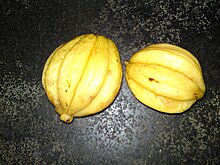Garcinia gummi-gutta
| Garcinia gummi-gutta | |
|---|---|

| |
| Scientific classification | |
| Kingdom: | Plantae |
| Clade: | Tracheophytes |
| Clade: | Angiosperms |
| Clade: | Eudicots |
| Clade: | Rosids |
| Order: | Malpighiales |
| Family: | Clusiaceae |
| Genus: | Garcinia |
| Species: | G. gummi-gutta
|
| Binomial name | |
| Garcinia gummi-gutta (
N.Robson | |
| Synonyms[2] | |
| |
Garcinia gummi-gutta is a
Although it has received considerable media attention purporting its effects on weight loss, there are reports of liver toxicity associated with the Hydroxycut commercial preparation containing the fruit extract, with clinical evidence indicating it has no significant effect on weight loss.[4][5][6]
Cultivation


Garcinia gummi-gutta is grown for its fruit in Southeast Asia and South Asia. Garcinia gummi-gutta is one of several closely related Garcinia species from the plant family Clusiaceae.[2][3] With thin skin and deep vertical lobes, the fruit of G. gummi-gutta and related species range from about the size of an orange to that of a grapefruit; G. gummi-gutta looks more like a small yellowish, greenish, or sometimes reddish pumpkin.[7] The color can vary considerably. When the rinds are dried and cured in preparation for storage and extraction, they are dark brown or black in color.[citation needed]
Phytochemicals
Although few high-quality studies have been done to define the composition of the fruit, its phytochemical content includes hydroxycitric acid which is extractable and developed as a dietary supplement.[5][6][8] Other compounds identified in the fruit include the polyphenols, luteolin, and kaempferol.[9]
Common names
In the Malabar Coast, it is known as kudam puli and in Tamil speaking areas of Sri Lanka and India, it is called goraka.[10][11]
Weight loss claims
In late 2012, a United States
While it has received considerable media attention purporting impact on
Adverse effects
In addition to possible liver damage, hydroxycitric acid can cause dry mouth, nausea, gastrointestinal discomfort, and headaches.[5][17]
Drug interactions
There is potential for Garcinia cambogia to interfere with
Culinary

Garcinia gummi-gutta is used in cooking, including in the preparation of curries to add a sour flavor.
Gallery
-
Bark
-
Cross section
-
Drying in smoke
See also
References
- . Retrieved 13 May 2024.
- ^ a b c "Garcinia gummi-gutta (L.) N.Robson". World Checklist of Selected Plant Families. Royal Botanic Gardens, Kew. Retrieved 1 June 2013 – via The Plant List. Note that this website has been superseded by World Flora Online
- ^ a b "Garcinia gummi-gutta". Germplasm Resources Information Network. Agricultural Research Service, United States Department of Agriculture. Retrieved 11 December 2017.
- ^ a b c d "Garcinia cambogia". National Center for Complementary and Integrative Health, US National Institutes of Health. 1 December 202. Retrieved 25 September 2021.
- ^ a b c d e f g h "Garcinia cambogia". Drugs.com. 28 May 2020. Retrieved 25 September 2021.
- ^ PMID 21197150.
- ^ "Fruit yellowish or reddish, size of an orange having six or eight deep longitudinal grooves in its fleshy pericarp. Pulp acid of a pleasant flavor. It is dried among the Singalese who use it in curries." Uphof, J.C. Th. (1968).
- S2CID 25194835.
- S2CID 29342259.
- S2CID 237487258.
- S2CID 220051712.
- ^ The Dr. Oz Show (November 5, 2012). Garcinia Cambogia: The Newest, Fastest Fat-Buster Archived 2014-04-21 at the Wayback Machine.
- ^ a b Christensen, Jen; Wilson Jacque (19 June 2014). "Congressional hearing investigates Dr. Oz 'miracle' weight loss claims". CNN Health. Retrieved 18 September 2016.
- PMID 9820262.
- S2CID 44094323.
- PMID 19360927.
- PMID 15234082.
- ^ a b "The acid rinds of the ripe fruit are eaten,." Drury, Heber (1873). "Garcinia gambogia (Desrous) N. 0. Clusiaceae". The Useful Plants of India, second edition. London: William H. Allen & Co. p. 220.
- ^ "G. Gummi-Gutta (Garcinia Cambogia) – An Ancient Indian Curry Condiment". US Premium Garcinia Cambogia. Archived from the original on 31 January 2019. Retrieved 5 May 2015.
- ^ "Kudampuli meencurry (fish curry with Malabar tamarind)". Secret Indian Recipe. Archived from the original on 30 April 2018. Retrieved 5 May 2015.
- ^ "Kaeng Som Kung (Sour Curry with Shrimp)". Saveur. 26 February 2015. Retrieved 5 May 2015.
- ^ "Gaeng Som Recipe, Thai Sour Curry Recipe of Shrimp, Okra and Roselle Leaves". Thai Food Master. 30 March 2011. Retrieved 5 May 2015.




